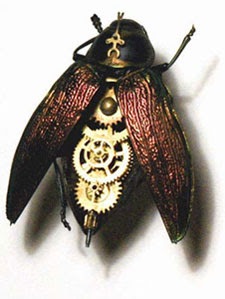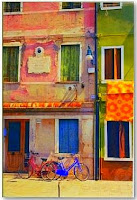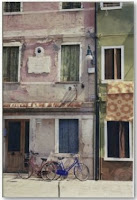After reviewing The Lightness of Being recently (post here), I began to consider how it takes such large machines to study the tiniest things. Then I spoke with someone who was asking about diffraction, and I explained that it is a visible manifestation of Heisenberg's uncertainty principle.
 [Airy Disk, image from the Wikipedia Commons. For a discussion, click here.] This shows the blur circle that results when parallel light of a single wavelength passes through a circular opening and is then focused to a "point" by a perfect lens. The radius of the first dark ring is given by the formula
[Airy Disk, image from the Wikipedia Commons. For a discussion, click here.] This shows the blur circle that results when parallel light of a single wavelength passes through a circular opening and is then focused to a "point" by a perfect lens. The radius of the first dark ring is given by the formulaThe ratio f/d is just the focal ratio, or f-number of the lens. What this firstly shows is that the absolute size of the Airy Disk is independent of the size of the lens, for a given ration of focal length f to lens diameter d. Thus, when your camera reports it is using f/4 to record a scene, the smallest dot its lens can make on the film or digital sensor is 2.44 times 4 times the brightest wavelength. If we use 0.6μ (600 nanometers, nm) as the "effective" wavelength for whitish light, that smallest dot is about 5.86μ. Let's call it 6μ. If you work out the uncertainty in the position of a photon that results from a given diameter lens, the Heisenberg formula will give the same answer, about 6μ when the ratio of the lens diameter to its distance from the recording medium is 1/4.
Most point-and-shoot digital cameras these days have pixels of 3μ x 3μ or smaller, which is why these small cameras try to use larger lens openings in the range f/2.5-f/3. The sensors in my digital SLR are closer to 7μ x 7μ, because the sensor is larger. That allows me to use smaller lens openings for some depth of field and still have a lot of detail in the image. This camera is more than twice the size and ten times the weight of a more ordinary pocket camera.
OK, I am getting ahead of myself here. I wrote above that the dot size depends only on the f/number of the lens. That is just the beginning of the story. Let's consider an f/4 system, because we have worked out the relevant figures just above. The blur circle is about 6μ in diameter. The "Rayleigh criterion" for resolving detail states that the center of one spot must be no closer to the center of the next than the radius of the blur circle. In such a situation, one bright center is on top of the dark ring of the next center. Two such spots in an f/4 system are thus 3μ apart.
Now let us consider three possible "eyes" with a focal ratio of f/4. First, we'll discuss a camera with a lens-and-sensor arrangement similar to the human eye in size. This is the situation with many pocket digital cameras. The sensor might record 10 mpx (megapixels), or 3650x2740, and have a size of 6mm x 4.6mm (6,000μ x 4600μ). The individual pixels are only 1.6μ x 1.6μ. The lens focal length for "normal" focus is about the size of the image sensor's diagonal dimension, or 8mm (8,000μ). At f/4, the lens diameter is 2mm (2,000μ) (The lens is bigger than this, allowing it to record images whose blur circle is closer to the size of the image pixels, but it can "stop down" to f/6 or f/8 to exclude excess light or allow greater depth of field).
No matter what the size of the pixels is, the smallest details that can be resolved are in the range of 3μ apart on the sensor. Effectively, 6,000/3 = 2,000 and 4,600/3 = 1,533, such that the true image "detail size" is 3mpx. Only for focal ratios near f/2 can you capture all the detail that sensor can resolve.
Now let us consider a "spider eye", with a lens-to-retina distance of about a millimeter. I picked a spider's eye because it is not segmented like the eyes of most insects, but is a tiny lens-and-retina eye. If such an eye has a lens diameter of 1/4mm (250μ), it will also be able to resolve details that are 3μ apart on the retina. But the largest possible retina that can be kept a millimeter from the lens has a size of less than 3mm x 3mm. Let us suppose the "sweet spot" or middle region is 1.5mm x 1.5mm (1500μ x 1500μ). Let us further assume that the nerve cells in the retina are smaller than 3μ (they are probably close to 2μ in diameter). Then it will be, in effect, a 500x500 pixel array, or about a quarter megapixel. That is sufficiently detailed for many uses, but is actually a bit blurrier than analog TV. Actually, the eye of a real spider uses a spherical lens almost in contact with its retina, so its focal ratio is f/1 or even smaller. This allows for more detailed seeing than an f/4 eye at such a small size, and works in darker environments.
Now let us consider a large landscape camera, of the type often called Graphic; Graflex was a favorite older brand of large camera. These typically were a foot long or more, and recorded on film sizes of 4"x5" (100mm x 125mm) or larger. Such cameras are still made, and some photographers still use large sheet film in them. They make stunning images. One can also get scanning backs for them to record digital landscapes, but they are very costly. How will such a costly system perform at f/4?
Parameters: Focal length about 12" or 300mm, diameter 3" or 75mm. A scanning back or film cassette size of 125mm x 100mm (125,000μ x 100,000μ) is commonly used with a lens of this length. Scanning backs have pixel sizes ranging from 5μ to 10μ, because they have resolution aplenty. A 100mm scanner with a 125mm travel and 10μ pixels will be using each pixel to the fullest. Its final image size is 12,500x10,000, or 125Mpx. That is more than forty times the detail than what we found for the digital camera considered above, and hundreds of times the detail that can be captured by the spider eye.
Now suppose you are using these three systems to look at an object just one meter from the camera lens, and about half a meter (500mm) across. The spider eye will cover the item with 500 pixels (or fewer) each way, seeing details no smaller than a millimeter. The small digital camera will record an image that is effectively 2000 pixels the large way, seeing details as small as 1/4 millimeter. This is about how well your eye does from half a meter away also. The Graphic camera will record near-microscopic details, with 12,500 x 10,000 pixels, recording details smaller than 1/20 mm, or 50μ.
Just considering visible light, it becomes clear that larger cameras are needed to record finer details. To see smaller details than this, or to resolve smaller features of far-away objects, the same principle holds, as I'll get into in the next day or two.


























